
SAN FRANCISCO — Neanderthals may have died off because they failed to harness the power of fire to the extent their human cousins did, a new data analysis suggests.
Using fire for cooking would have allowed these other groups of ancient human relatives to get more calories from the same amount of food, thereby edging out the Neanderthal population. Over time, the anatomically modern human population would have risen, while the Neanderthal population plummeted toward extinction, according to the model.
"Fire use would have provided a significant advantage for the human population and may indeed have been an important factor in the overall collapse or absorption of the Neanderthal population," said Anna Goldfield, a doctoral candidate in archaeology at Boston University, who presented the findings here on Thursday (April 16) at the 80th Annual Meeting of the Society for American Archaeology. [The Top 10 Things That Make Humans Special]
Mysterious disappearance
One of the enduring mysteries of human history is why the Neanderthals went extinct in most of Europe around 40,000 years ago. Neanderthals had been living on the continent for hundreds of thousands of years when the first modern humans showed up about 45,000 years ago, Goldfield said. Then, in a relatively short span of time, the Neanderthals vanished.
"The arrival of humans had something to do with the extinction of Neanderthals," Goldfield told Live Science.
But the exact cause has been a matter of hot debate. Some have postulated that Neanderthals found it increasingly difficult to access resources they needed given their small group sizes and relatively local trading networks. Other scientists have even proposed that humans cannibalized their Neanderthal rivals.
Sign up for the Live Science daily newsletter now
Get the world’s most fascinating discoveries delivered straight to your inbox.
"The issue of Neanderthal extinction is very complex, and very little is agreed upon," Goldfield said.
Goldfield and her colleague Ross Booton, a mathematical biologist at the University of Sheffield in the United Kingdom, wondered whether fire use had something to do with the demise, they said.
One big difference between the Neanderthals and humans may have been modern humans' mastery of fire. Not only can it provide warmth, but fire also enables people to cook their food. This can kill bacteria, making food safer, and denature proteins, meaning the body can harness more calories from the same amount of food. In addition, Neanderthals may have required more calories to survive in the first place because they had higher average body mass. Thus, modern humans' lower food needs could have given them a decisive edge in the cold, nutritionally sparse environment of Western Europe at the time, Goldfield said.
While some fossil sites suggest Neanderthals used fire, they may not have used it often or consistently. For instance, Neanderthals occupied two sites in southwest France — Roc de Marsal, and Pech de l'Aze IV — for tens of thousands of years. The sites contain tens of thousands of stone tools and animal bones, but almost no evidence of fire making, said Dennis Sandgathe, an archaeologist at Simon Fraser University who has excavated the sites.
"The Neanderthals are somehow just getting by without fire," Sandgathe told Live Science.
Competing resources
To understand the effects of fire use on Neanderthals, the researchers used mathematical models. The simulations helped estimate how the populations of anatomically modern humans and Neanderthals changed when humans were using fire more frequently than Neanderthals, or when both groups used fire about equally. The researchers also looked at the population of reindeer, which both groups ate, under those scenarios.
The numbers showed that the more that modern humans used fire relative to their Neanderthal cousins, the more likely the human population was to increase slightly. That, in turn, would have reduced the number of reindeer available for the Neanderthals to eat. Over time, the human population would have simply outcompeted the Neanderthals for resources, leading to this population's eventual demise.
However, because so much remains unknown about Neanderthals, it's tough to draw firm conclusions about the causes of their decline, Sandgathe said. For instance, estimates for how many calories Neanderthals needed to survive are rough, he said. In addition, scientists still don't agree on exactly what Neanderthals ate. Whether Neanderthals ate plants or were ultra-carnivorous (or even cannibals) could affect the extent to which fire affected their survival, he added.
Follow Tia Ghose on Twitter and Google+. Follow Live Science @livescience, Facebook & Google+. Originally published on Live Science.

Tia is the managing editor and was previously a senior writer for Live Science. Her work has appeared in Scientific American, Wired.com and other outlets. She holds a master's degree in bioengineering from the University of Washington, a graduate certificate in science writing from UC Santa Cruz and a bachelor's degree in mechanical engineering from the University of Texas at Austin. Tia was part of a team at the Milwaukee Journal Sentinel that published the Empty Cradles series on preterm births, which won multiple awards, including the 2012 Casey Medal for Meritorious Journalism.











